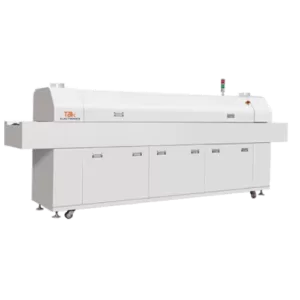
IR Reflow Oven
The IR reflow oven is suitable for infrared radiation curing of the surface coating of the PCB board. This model of IR3C can just meet the curing requirements in the surface spraying process of the PCB board.
It is not only simple in structure, fast curing speed, high production efficiency, but also can reduce production space and has good curing quality. It has become an advanced IR reflow oven in the world.
1. Control Panel System
- It uses a convenient and simple control panel, which is easy to operate for this IR reflow oven.

2. Heating System
- Adopt the PLC temperature controller and button control, it can achieve precise temperature control in 2 temperature zones.
- Equipped with 2 temperature zones, it has 6 heating pipes in each temperature zone, to minimize energy consumption.
2. Heating System
- Adopt the PLC temperature controller and button control, it can achieve precise temperature control in 2 temperature zones.
- Equipped with 2 temperature zones, it has 6 heating pipes in each temperature zone, to minimize energy consumption.

3. Transportation System
- Use of chain conveyor mode, the width of the chains can be adjusted between 50-450mm.
- In order to meet the customer’s multiple connection ways, the chain uses stainless steel and an extended pin chain.
4. Guide Rail Structure
- It is adopted with the specially reinforced aluminum alloy guide rail which can withstand high temperatures.
- Also, the guide rail supports an adjustment mechanism to ensure minimum deformation.
- The shaking problem of the track is avoided, and eliminate the dropping issue of the PCB board.
5. Adjustable Transportation Speed
- Adopt specially reinforced aluminum alloy guide rails, which can withstand high temperatures and cooperate with the support adjustment mechanism to ensure the minimum amount of deformation.
- The track is prohibited from shaking, and the phenomenon of failing off the board is eliminated.
Infrared Reflow Oven
IR (infrared) reflow ovens utilize infrared radiation to heat printed circuit boards (PCBs) and solder assembly components for reflow soldering. The intense infrared energy allows rapid and targeted heating needed to form high quality solder joints. IR reflow provides advantages in certain applications, but also has some limitations to consider.
Key Features of IR Reflow Ovens
IR reflow ovens contain the following distinguishing features:
Infrared Heating Elements
IR ovens use infrared emitters like quartz halogen lamps instead of traditional convection or conduction heating elements. These heat the boards and components directly and rapidly.
Rapid Heating
Infrared radiation allows very fast heating, reducing reflow cycle times. However, this can also lead to thermal shock if not properly managed.
Temperature Controls
Specialized pyrometers monitor temperatures and adjust the infrared output as needed to follow reflow profiles.
Smaller Size
IR ovens take up less space since the infrared emitters provide targeted heating without large surrounding ovens.
Advantages of IR Reflow Ovens
Some benefits that IR reflow ovens provide:
Fast Process Speed
The rapid infrared heating greatly reduces soldering cycle times.
Energy Efficiency
Less energy is wasted compared to heating an entire convection oven.
Flexible and Adaptable
Different IR emitters allow tuning the process for specific board designs.
Improved Solder Joint Quality
Faster reflow ramps can reduce soldering defects in some cases.
Limitations of IR Reflow Ovens
Some drawbacks and limitations include:
Higher Cost
The specialized emitters and controls make IR ovens more expensive than convection ovens.
Limited Board Size
Most IR ovens have smaller chamber sizes which limits board dimensions.
Complex Profile Tuning
The fast heating dynamics require more complex profile tuning to avoid defects.
Comparison to Convection and Hot Air Ovens
IR ovens differ from convection and hot air ovens in:
Heating Method: Infrared vs hot air or convection heating
Speed: Much faster process times with infrared
Board Size: Typically smaller maximum board size
Evenness: More tuning required for uniform heating
Cost: More expensive than convection ovens
Selecting an IR Reflow Oven
Key factors when selecting an IR reflow oven:
Production Volume
High volume manufacturing may require a convection oven. IR suits low to medium volumes.
Board Size
Ensure the oven can accommodate the board dimensions.
Budget
IR ovens range from $5000 to $50,000+ depending on size and features.
Experience Level
The complexity of IR ovens may require experienced users.
Using IR Reflow Ovens
To use an IR reflow oven effectively:
Loading Boards
Use proper fixturing to hold boards in place during rapid heating.
Profile Creation
Develop and tune custom temperature profiles for each board design.
Process Monitoring
Monitor and inspect the reflow process closely to catch any issues.
Cool Down
Controlled cooling is critical to avoid damage from thermal shock.
Case Studies of IR Reflow Ovens in Manufacturing
An electronics manufacturer used IR reflow to solder high mix/low volume boards with fine pitch components. The fast ramp speeds resulted in excellent solder joint quality.
A medical device company used IR reflow to solder temperature sensitive components onto flexible PCBs without damage. The targeted heating prevented warping.
Safety Considerations for IR Ovens
Important safety practices for IR reflow ovens:
Protect operators from direct IR exposure
Provide adequate ventilation for fumes
Follow electrical and fire safety precautions
Allow boards to cool fully before handling
Solving the PCBA industry biggest problems
Working with ElectronicsTalk offers you high-standard PCBA products that are supplied from credible manufacturers in attractive cost.
We dedicate to provide the best customer support, its the vital aspect of our company philosophy.

